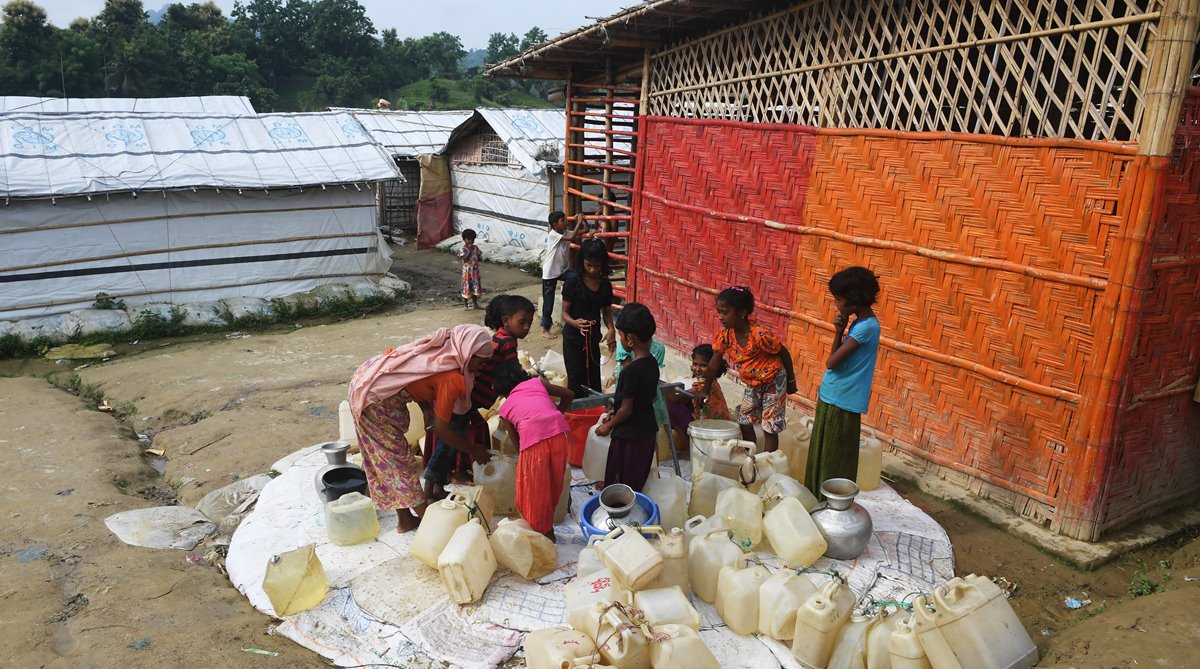WHO’s first guidelines to improve care for women with sickle cell disease
Current clinical guidelines for managing SCD in pregnancy have been largely based on protocols from high-income countries, the WHO noted.
WHO says severe funding crunch is threatening the continuity of life saving health services in the Rohingya camps in Bangladesh
SNS | Cox's Bazar | August 24, 2018 8:33 pm

Rohingya refugees collect drinking water at the Unchiprang refugee camp in Teknaf near Cox's Bazar, Bangladesh. (Photo: AFP)
Efforts by the Bangladesh government, the World health Organization (WHO) and health partners in the past year have helped save thousands of lives, and prevented deadly disease outbreaks among the nearly 1 million Rohingya refugees, claims WHO. However, it says, the Rohingya population still remain vulnerable with their evolving health needs. According to the WHO, severe funding crunch is threatening the continuity of life saving health services in their camps in Bangladesh.
“Unprecedented efforts have been made in the last year and in the most challenging conditions. Deadly diseases such as cholera have been prevented, and measles and diphtheria curtailed rapidly with quick roll-out and scale-up of health services and mass vaccination campaigns. It is remarkable that not only has the mortality rate among the Rohingyas remained lower than expected in an emergency of such a scale, it has also reduced significantly in the last six months,” said Dr Poonam Khetrapal Singh, Regional Director, WHO South-East Asia. She said the Government of Bangladesh and health partners’ work on the ground was commendable.
Advertisement
EDITORIAL | Suu Kyi gets dodgy
Advertisement
In one of the largest ever population influxes over a short span of time, nearly 700,000 Rohingyas have arrived in Cox’s Bazar area since 25 August, 2017. People arrived with injuries, low immunisation coverage, high rates of malnutrition, in need of reproductive health care and psycho-social support, and at risk of deadly disease outbreaks. Along with the Bangladesh Ministry of Health and Family Welfare, says WHO, it coordinated emergency health services assisted by the nearly 107 health partners on the ground to ensure access to essential services for the Rohingyas settled in mega and small camps.
In the past one year, 155 health posts have been established, each catering to around 7700 people. Besides, 60 primary health care facilities covering 20,000 people each, and 11 secondary care facilities being accessed by nearly 115,000 people each have also been established.
“With generous support from KSrelief, 86 staff has been added to the workforce of the Cox’s Bazar district hospital, the only facility providing referral services to the vulnerable population and the host community,” the WHO has said in a statement.
“We have done things that collectively we can be proud of. However, we need to continue to support the health needs of this vulnerable population and remain vigilant against the spread of diseases. This is still a very fragile situation,” says Dr Peter Salama, WHO’s Deputy Director-General for Emergency Preparedness and Response, who recently visited the Rohingya camps in Cox’s Bazar.
Listing the measures, the WHO says 4 million doses of vaccines against cholera, polio, measles and rubella and diphtheria and tetanus have been administered to children, adolescents and adults through multiple mass vaccination campaigns, preventing major disease outbreaks and saving thousands of lives. Besides, childhood immunisation has been established with 94 sites delivering lifesaving vaccines to children.
At least 152 health facilities covering 98% of the refugee population are now implementing disease surveillance through the Early Warning Alert and Response System.
Coordinating monsoon contingency plan, preparedness and response for acute watery diarrhoea, and diphtheria outbreak, WHO claims to have delivered nearly 175 tonnes of medicines and supplies and “pre-positioned emergency supplies in three locations for the monsoon and cyclone season. WHO has distributed water filters prioritizing health posts and centers and households with pregnant women”.
WHO is also building the capacity of health workers to provide mental health and psychosocial support services to the Rohingya refugees.
Despite these efforts, the WHO says, challenges remain, with floods and landslides in the ongoing monsoon season continuing to displace people and affecting the functioning of health facilities. The Rohingya population is reluctant to access sexual and reproductive health services, as a result of which 70% of the births are still taking place outside of health facilities.
The biggest challenge is the need to further scale up services to meet the complex, evolving and long term health needs of this highly vulnerable population amidst a funding shortfall that also threatens to undo the gains and progress made so far.
WHO has appealed for US$ 16.5 million for its continued support to the Rohingya refugees, which is part of the US$ 113.1 million being sought by all health partners together under the Joint Response Plan until March 2019.
Dr Bardan Jang Rana, WHO Representative to Bangladesh, says, “We need generous and continued support of our partners. It is important that the Rohingya people do not suffer anymore. We need to find sustainable ways of meeting their needs for health, water, sanitation, education, and livelihood.”
Advertisement
Current clinical guidelines for managing SCD in pregnancy have been largely based on protocols from high-income countries, the WHO noted.
On May 22, the world celebrated the International Day for Biological Diversity, at a time when the disappearance of species is at the highest rate in human history.
Prime Minister Narendra Modi, in his address to the nation on Mann Ki Baat, stated that an MoU was signed in the presence of WHO Director General and his “friend Tulsi Bhai” (Dr Tedros Adhanom Ghebreyesus).
Advertisement
